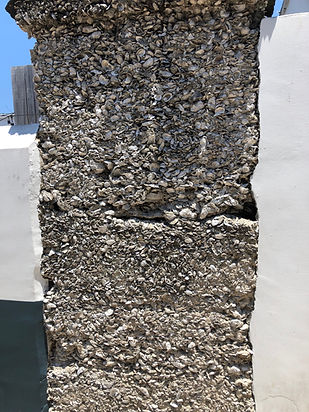

the
HISTORY
OF
TABBY

Tabby was used by early Spanish settlers from North Carolina to Florida, then by English colonists primarily in Coastal South Carolina and Georgia. After the colonial period, bricks were costly to build and transport, thus, Tabby was the method of construction along the Sea Islands. The materials were found from shell mounds and middens in the tidal rivers and creeks.


Tabby is composed of shells, lime and sand in equal portions.
They are well mixed together upon a floor with water, then put into boxes the thickness of your walls. The boxes are made of good boards and are kept apart by pens and every three or 4 feet which as soon as the tabby begins to harden are driven and the boxes save for another round..........
This in the summer will be in two or three days. Care must be taken in caring up your walls, that they be kept straight by a line and perpendicular with a plum-bob. As Tabby is very strong and the walls need not to be any thicker than a brick house. Care must be taken that they are not run up too fast, lest heavy rains, high winds, or their own weight while green, will bring them down. When dry they become like a heap of living rock, and grow stronger with the time. They are the cheapest buildings I know of, the easiest in construction, may be made very beautiful and very permanent. They are the buildings in Spain, the boasts of Barbary where some of them have stood there for many centuries. All the success is taking the boxes carefully carefully mixing the material and through a dry season."
-Thomas Spalding from Sapelo Island, 1816
Tabby ruins are significant as an example of Tabby construction

Stoney Banyard Ruins, Hilton Head Island, S.C.
circa 1726
Tabby column St. Augustine Fla.
circa 1780


Tabby barrier wall Beaufort, S.C.
circa 1730



Chocolate Plantation, Sapelo Island, G.A.
circa 1815-1819


.jpeg)
Darien, G.A.

